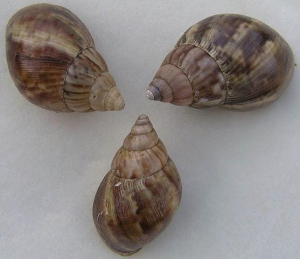What would you do if you saw a large 3 to 4 inch snail, like the one in the header, crawling across your driveway? Before you deem something to be detrimental to your landscape, accurate identification is critical. A very small percentage of insects and other critters are actually pests, and many are in fact beneficial. They help to break down organic material to create compost, pollinate plants to produce fruits and vegetables, and consume or parasitize pest insects. A good gardener should make it a priority to know the good guys.
Here is a great example of why it’s important to know the good guys. Conscientious homeowners recently brought a large snail to the office because they were convinced it was the invasive giant African land snail. They were being good stewards and wanted to alert regulators that the snail has in fact inched it’s way into northeast Florida. As it turns out, the snail was the rosy wolf snail, Euglandina rosea, a predatory snail. This is a classic case of mistaken identify because this snail will eat other snails and slugs in your landscape and garden.
So the rosy wolf snail is one that you might want to keep around. It finds it’s prey by following the slime trails. They move pretty slow but once they are hot on a trail, they quickly outpace their prey. Although they get large, reaching 3 to 4 inches in length, this is about half the size of the giant African land snail. The rosy wolf snail is often misidentified as the invasive Giant African land snail but there are distinct differences.

Here are some characteristics of the giant African land snail.
- The Giant African land snail may reach up to 8 inches in length and 5 inches in diameter.
- The shell is conical in shape, tapering to a distinct point at one end and rounded at the other.
- They are usually light brown in color with dark brown stripes.
For more info on the Giant African land snail, click here: http://edis.ifas.ufl.edu/in904
If you find something that you can’t identify, County Extension Agents are there to help. Click here http://sfyl.ifas.ufl.edu/find-your-local-office/ for an interactive map to help you locate your County Extension Office.
 0
0
